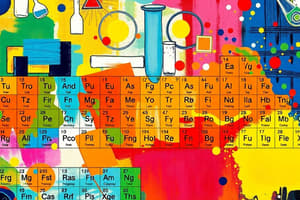Podcast
Questions and Answers
Which characteristic is unique to noble gases compared to other elements?
Which characteristic is unique to noble gases compared to other elements?
- Conductivity of electricity
- React vigorously with water
- Full outer shell of electrons (correct)
- High melting points
What is a key difference between alkali metals and alkaline earth metals?
What is a key difference between alkali metals and alkaline earth metals?
- Alkali metals tarnish quickly
- Alkali metals contain 1 electron in their outer shell (correct)
- Alkali metals react less vigorously with water
- Alkali metals are harder than alkaline earth metals
Which of the following is NOT a physical property of halogens?
Which of the following is NOT a physical property of halogens?
- Usually gases at room temperature
- Sparingly soluble in water
- Low melting point increases down the group
- High melting point (correct)
Which of the following statements accurately describes alkaline earth metals?
Which of the following statements accurately describes alkaline earth metals?
What distinguishes transition metals from alkali metals in terms of reactivity?
What distinguishes transition metals from alkali metals in terms of reactivity?
Which aspect is true regarding the physical properties of alkali metals?
Which aspect is true regarding the physical properties of alkali metals?
Which chemical property is characteristic of halogens?
Which chemical property is characteristic of halogens?
What is a common characteristic of transition metals?
What is a common characteristic of transition metals?
Which statement holds true for alkali metals compared to alkaline earth metals?
Which statement holds true for alkali metals compared to alkaline earth metals?
What is the primary principle used to arrange elements in the modern periodic table?
What is the primary principle used to arrange elements in the modern periodic table?
What was Robert Boyle's key contribution to the understanding of elements?
What was Robert Boyle's key contribution to the understanding of elements?
What was the significance of the gaps left in Mendeleev's periodic table?
What was the significance of the gaps left in Mendeleev's periodic table?
What discovery did Johann Dobereiner make regarding elements arranged in triads?
What discovery did Johann Dobereiner make regarding elements arranged in triads?
How did Henry Moseley's work influence Mendeleev's periodic table?
How did Henry Moseley's work influence Mendeleev's periodic table?
Why did John Newlands' octave pattern face criticism?
Why did John Newlands' octave pattern face criticism?
What role did electrolysis play in the development of the periodic table according to Humphry Davy?
What role did electrolysis play in the development of the periodic table according to Humphry Davy?
What significant change did Henry Moseley's research introduce to the understanding of atomic structure?
What significant change did Henry Moseley's research introduce to the understanding of atomic structure?
Which element's placement in Mendeleev's periodic table was influenced by chemical properties rather than atomic weight?
Which element's placement in Mendeleev's periodic table was influenced by chemical properties rather than atomic weight?
Which group of elements did the ancient Greeks believe comprised all matter?
Which group of elements did the ancient Greeks believe comprised all matter?
Flashcards are hidden until you start studying
Study Notes
Fundamental Principles of the Periodic Table
- Elements are arranged in increasing atomic number, reflecting their similar chemical properties.
- Traditionally, the Greeks believed everything was made up of four elements: Earth, Fire, Air, and Water.
Contributions to the Concept of Elements
- Robert Boyle defined an element as a substance that cannot be broken down into simpler substances through chemical means.
- Johann Dobereiner discovered that in a triad of elements, the atomic weight of the middle element is the average of the other two.
Historical Progression in Periodic Table Development
- John Newlands introduced the octave pattern, where every eighth element exhibited properties similar to the first, but it lacked gaps for undiscovered elements.
- Henry Moseley rearranged the periodic table by atomic number, determining the number of protons using X-ray techniques.
- Dmitri Mendeleev prioritized chemical properties over atomic weight when placing iodine and tellurium in his periodic table.
Importance of Electrolysis and Gaps
- Humphry Davy's electrolysis method enabled the isolation of potassium and sodium and the breakdown of water into hydrogen and oxygen.
- Gaps in Mendeleev's periodic table were significant as they predicted the presence of yet-to-be-discovered elements.
- Moseley's discovery of atomic numbers facilitated a more accurate arrangement of elements based on atomic number rather than weight.
Mendeleev's Limitations
- Mendeleev did not anticipate argon’s existence due to the lack of discovery of noble gases at that time.
Comparison of Periodic Tables
- Mendeleev’s Periodic Table was based on atomic weight, while the modern table is based on atomic number.
- Mendeleev’s table included gaps for unknown elements, unlike the modern table which reflects all known elements.
- Structurally, elements in Mendeleev's table were organized differently compared to the more systematic arrangement in the modern table.
Physical and Chemical Properties of Elements
Alkali Metals
- Physical: Low density, float on water, shiny but tarnish quickly.
- Chemical: Extremely reactive, one electron in outer level, must be stored under oil, react vigorously with water.
Alkaline Earth Metals
- Physical: Harder than alkali metals, good electrical conductors, tarnish readily after cutting.
- Chemical: Less reactive with water than alkali metals, have two valence electrons, but still very reactive.
Halogens
- Physical: Often liquid or gas at room temperature, low melting points increasing down the group, sparingly soluble in water.
- Chemical: React violently with alkali metals to form salts, react with hydrogen to create acids.
Noble Gases
- Physical: Gases at room temperature, colorless, odorless, and non-flammable.
- Chemical: Least reactive elements due to full outer electron shells.
Transition Metals
- Physical: Very hard, high melting points, good electrical and heat conductors, usually tough.
- Chemical: Form colorful compounds, often serve as catalysts, and have varied reactivity, generally less reactive than alkali metals.
Studying That Suits You
Use AI to generate personalized quizzes and flashcards to suit your learning preferences.




